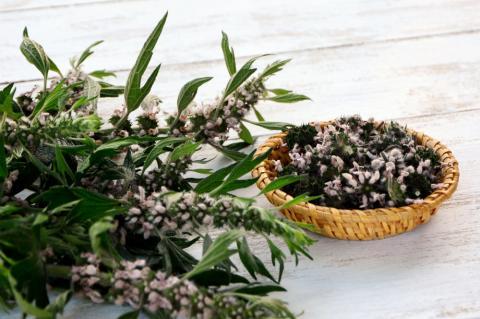
Wait, you might be thinking, mints can be bitter? Yup…not all mints have a lovely aroma and flavor. But this doesn’t mean they aren’t great medicine. Some of my favorite all-time herbs are bitter mints. In fact, I just processed pounds-worth of one of them, motherwort, yesterday with my herb-growing friend.
Bitter mints in general are fantastic for digestion, as digestive bitters. Their bitter flavor signals to the digestive system to make digestive fluids and enzymes in the mouth, stomach, intestines, and even liver. Improved digestion means better nutrient uptake from your food and less gas and inflammation in the digestive tract that is triggered by partially digested food molecules. As such, bitter herbs may help a variety of issues in the body that are worsened by inflammation in the gut, which doesn’t stay localized in the gut and can lead to achy joints, allergies, and even mood imbalances, for example.
But bitter mints have even more to offer, aside from acting as digestive bitters. And mints in general are perennial, so easy-to-grow for yourself. Just remember that many mints can hybridize, so keep them separate in your garden. Consider, also, growing them in containers not immediately next to each other.
Motherwort
I take this gorgeous mint daily. Motherwort (Leonurus cardiaca) helps with lots of things.
- Heart Health: Motherwort helps normalize heart rhythm, lower blood pressure, and strengthen heart function. Its botanical name says it: Leonurus cardiaca means lion-hearted.
- Sedating: Motherwort is a sedating herb and is a comforting one to reach for when dealing with fear, anxiety, or the beginnings of a full-on anxiety attack.
- Thyroid Health: Motherwort has also been used as adjunctive support for overactive thyroid function.
- Growing & Harvesting Motherwort: This is a beautiful, easy-to-grow mint topped with lovely blue flowers at the top of a towering plant (I’ve seen them up to 5 feet tall!). The seeds need to be sown in the fall so that they’re exposed to the necessary winter temperatures to stimulate germination in the spring, but you can also stratify the seeds yourself. It will grow in most soil types and does fine in full sun, partial shade, and even heavier shade. Be aware that it will reseed like crazy. If you’re using it as an ornamental, be sure to cut it back to around 4-6 inches before the flowers go to seed. If you’re using it as medicine, you’ll cut it back similarly, while it’s in flower, and strip the leaves and flowers for use. Motherwort grows in hardiness zones 4-8.
Skullcap
Skullcap (Scutellaria lateriflora) is another lovely mint with particular affinity to the nervous system. It’s not a bad idea to grow your own for medicinal use, given that there has been adulteration with the herb germander, which causes liver damage. Skullcap itself does not. If you aren’t growing your own, stick to organically grown skullcap from well-respected herb suppliers.
- Calming: Motherwort can be outright sedating. Skullcap, on the other hand, is calming without making you sleepy if you keep the dose lower. (Higher doses may make one sleepy.) This is a great herb for daytime tension, when you need to be productive, but also for nighttime when a restless mind or body is preventing you from sleeping. It’s used for looping…when the mind keeps cycling around and around obsessively on a thought and it’s hard to stop. Even though it’s not overtly sedating the way that motherwort is, skullcap may be a good part of a blend for preventing anxiety attacks. It’s the first herb (together with vervain) that I ever used for a panic attack in myself (I was making medicine with both at a workshop at the California School of Herbal Studies at the moment…that was convenient).
- Analgesic: Skullcap is used by herbalists for pain, especially nerve-related pain, muscle cramps, and headaches. Often a low dose of the extract is sufficient.
- Transitioning Off Of Medications/Drugs: This is a particularly valuable use for skullcap, helpful for folks coming off of addictive prescription medications, smoking, and alcohol to support the nervous system. Consult with a trained herbalist and your doctor before combining with any medications.
- Growing & Harvesting Skullcap: The blue-violet flowers of skullcap are a lovely addition to the garden. Like motherwort, the seeds need stratification, though either plant can be easily propagated by root division. In the wild, it’s found along streams, in the woods and in the underbrush. Skullcap grows in full sun to part shade (part shade seems best) and needs regular watering. It will tolerate wet soils, and does well in rich soils. Skullcap will do fine in a wide range of climates (USDA hardiness zones 3-9). It’s collected like motherwort…cut it down to 4 or so inches above the ground when in bloom. The leaves and flowers of this one need to be tinctured fresh, while motherwort is fine as a fresh or dry plant preparation.
Wood Betony
The showy, long lasting flowers of wood betony (Stachys betonica, aka. Stachys officinalis) which grow at the top of the stem and also further down are pink to pinkish-purple which are a nice contrast to the blues and purples of motherwort and skullcap in the garden. The flavor of wood betony has been likened to black tea, so not as bitter as motherwort or skullcap.
- Digestive Support When Stressed: Wood betony as a tea or liquid extract is used when tension or nervousness is manifesting in the digestive system. Think “butterflies in the stomach.”
- Nerve Support: A traditional herb for neuralgia, which is a burning, stabbing pain resulting from an inflamed or damaged nerve. It may also provide some aid for a pinched nerve, as in sciatica.
- Menstrual Cycle Issues: Another traditional usage for this lovely herb is for those painful, slow starting periods, often starting with dark colored or clotty menstrual blood (a situation known as dysmenorrhea). Wood betony is used to help bring the period on while easing the discomfort.
- Growing & Harvesting Wood Betony: This is hardy to zone 4. It grows to about 1-2 feet tall and is native to woodland areas and thickets. Seeds or cuttings are easy to get going. It’s a great plant for dappled shade, which will also slow down its spread (it’s a mint, after all…). If in full sun, it may spread quickly. If that’s a problem, plant it in part shade to slow it down. Harvest the flowering stem and leaves, discarding any of the stem that’s tough. Hang in a dark place to dry if not tincturing, then store plants as whole as possible in a glass jar, as soon as the plant dries.








